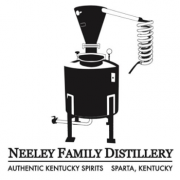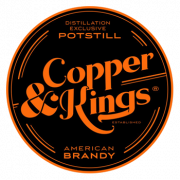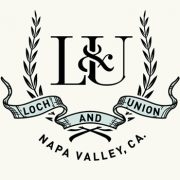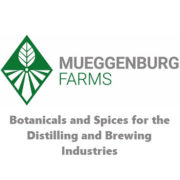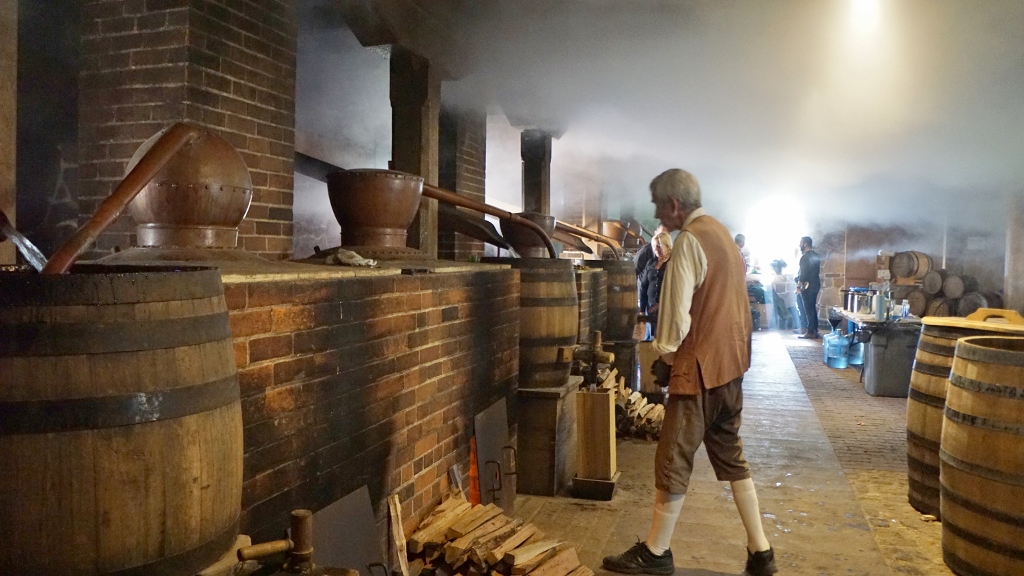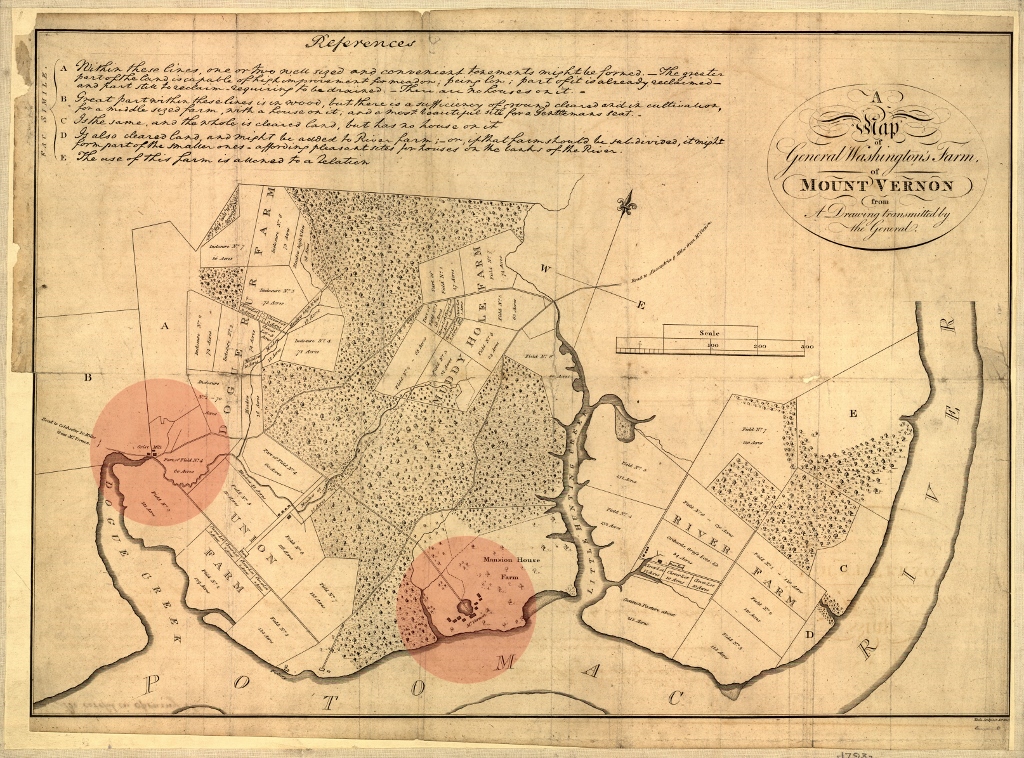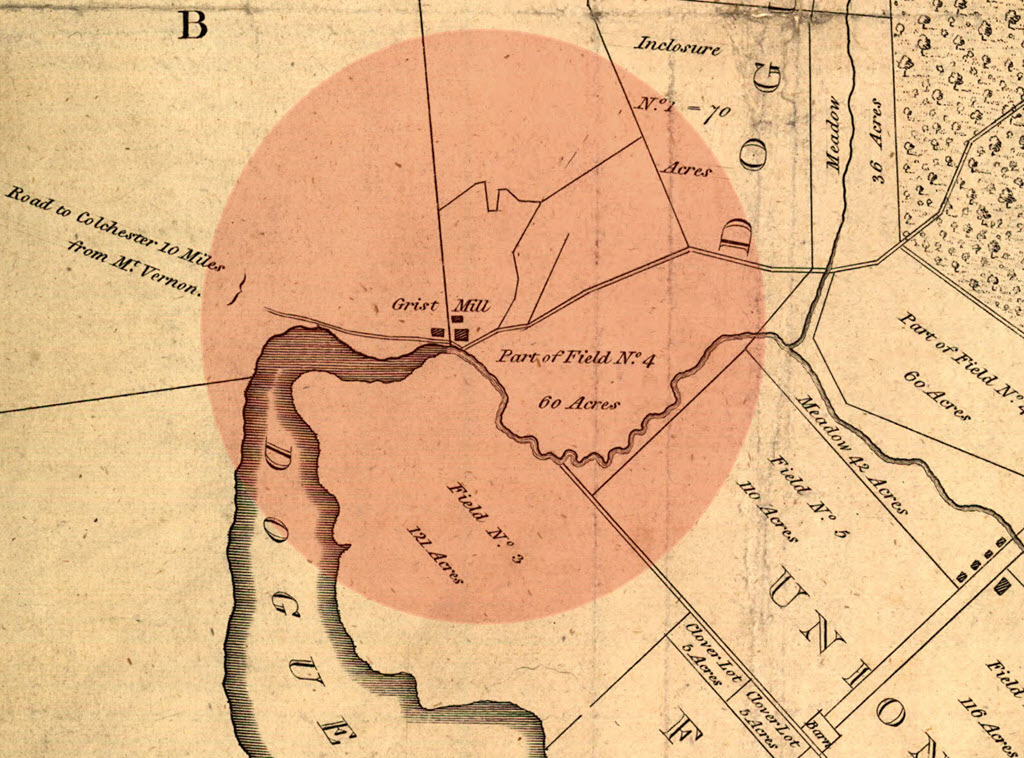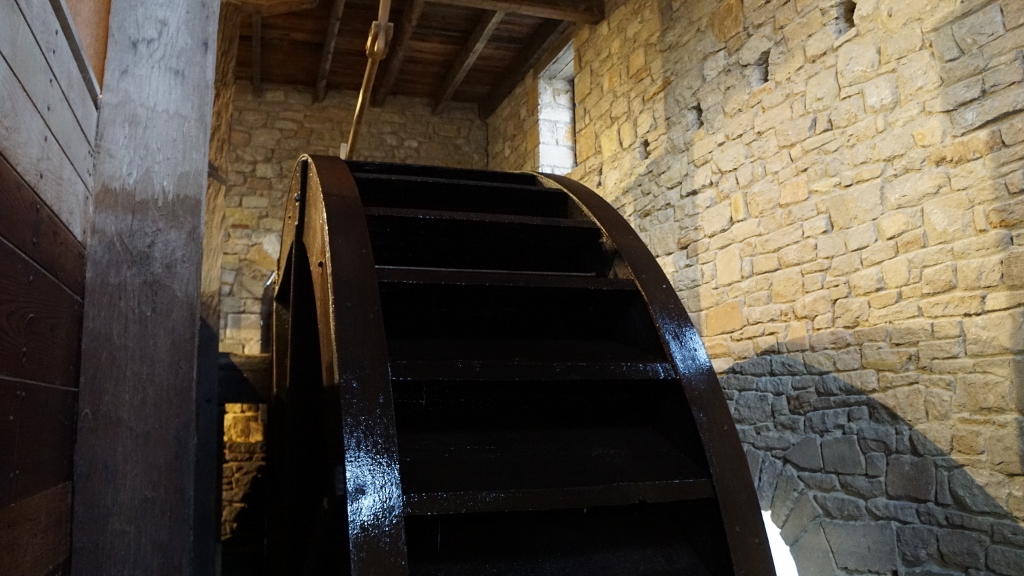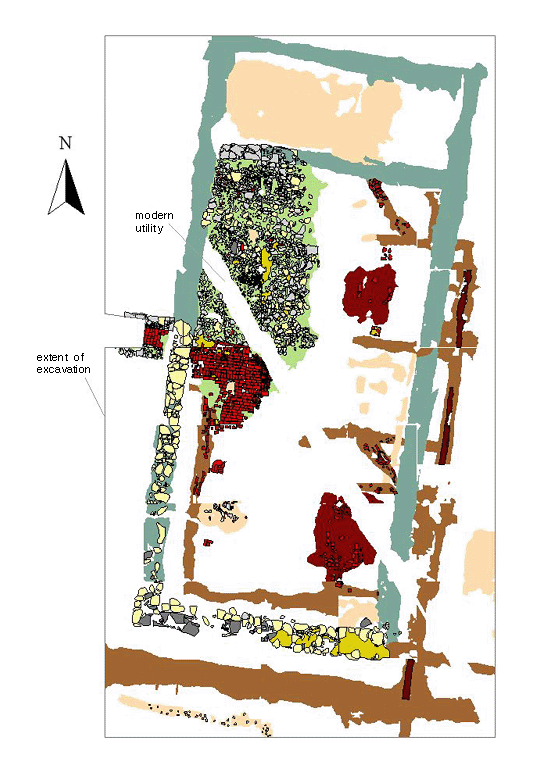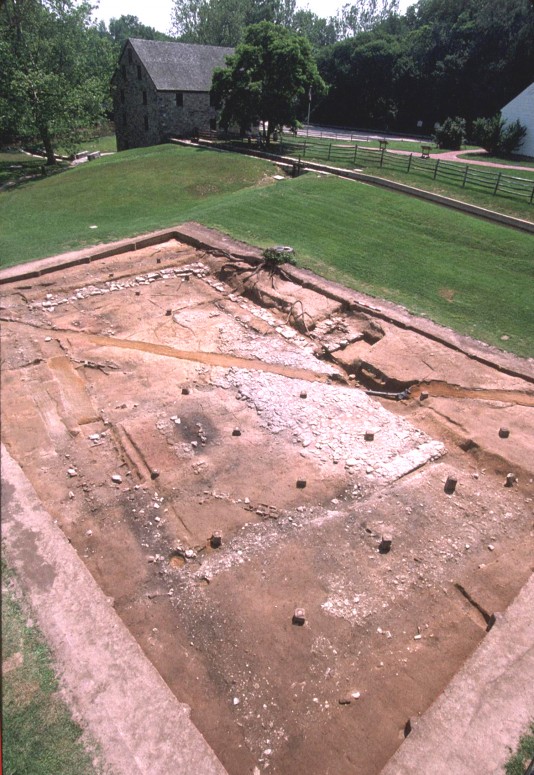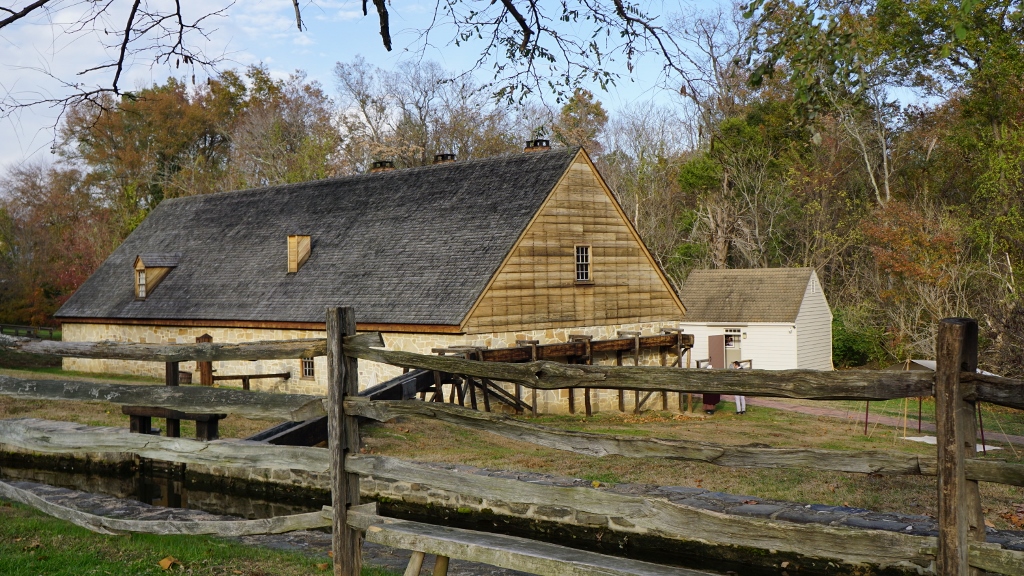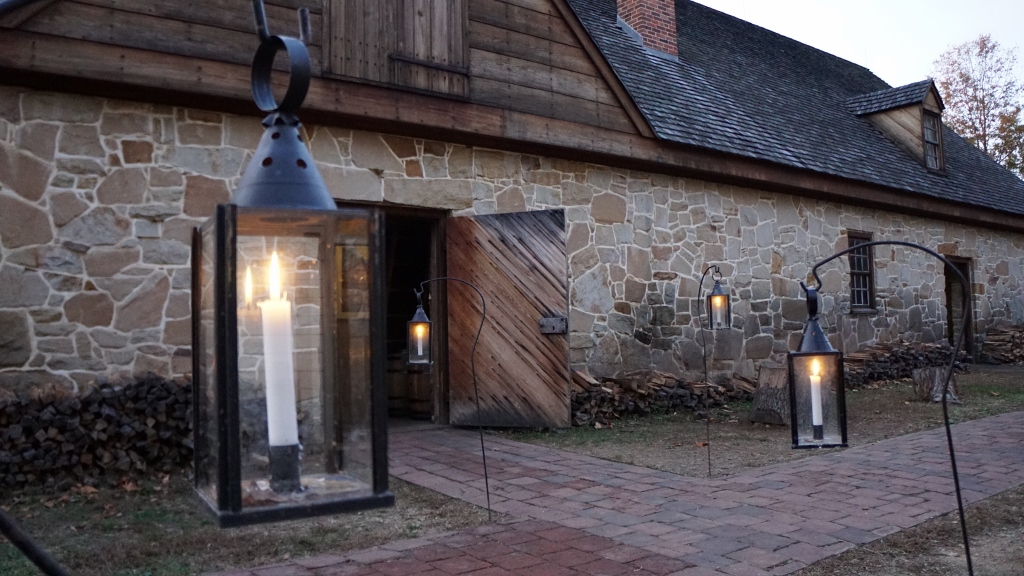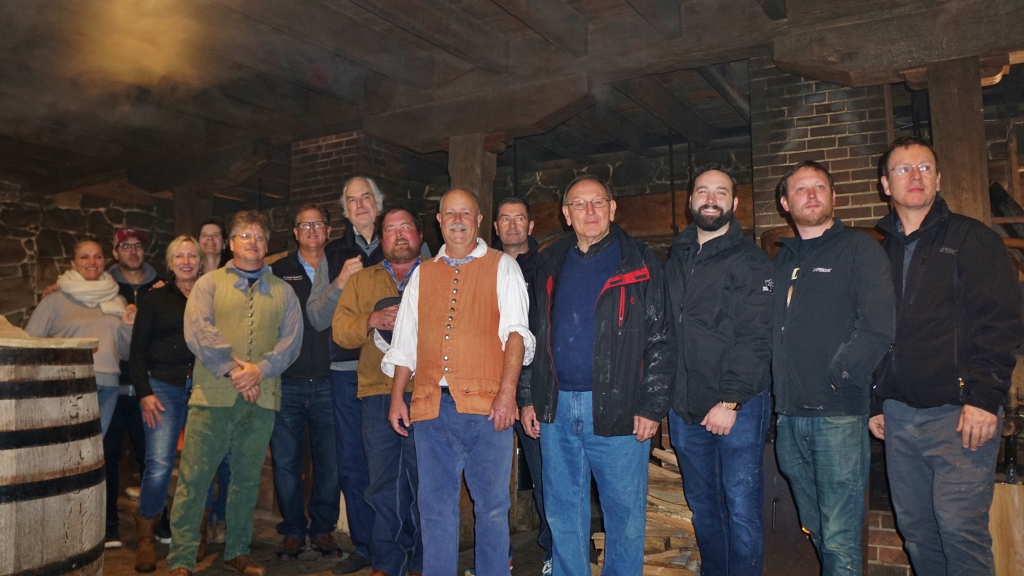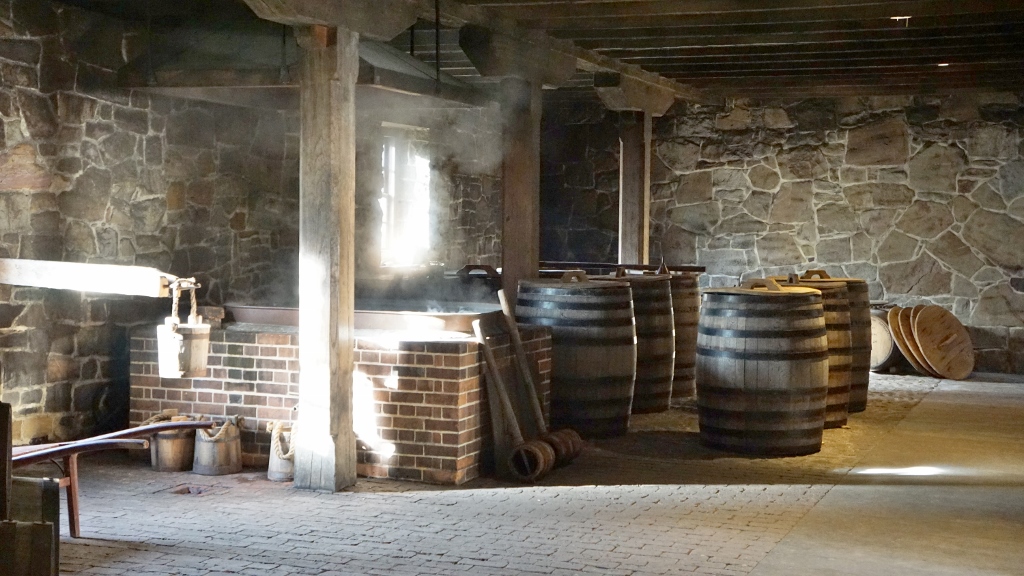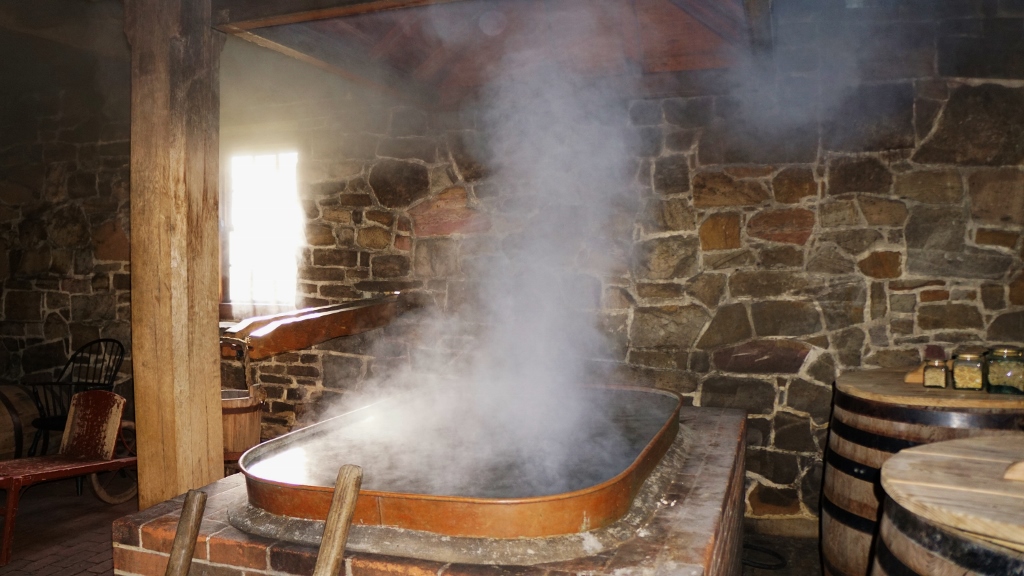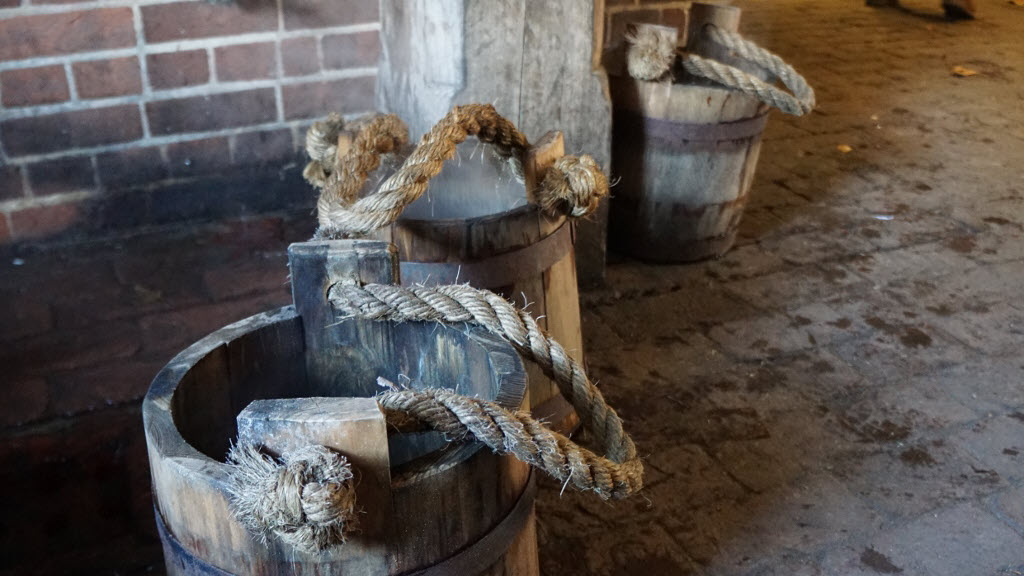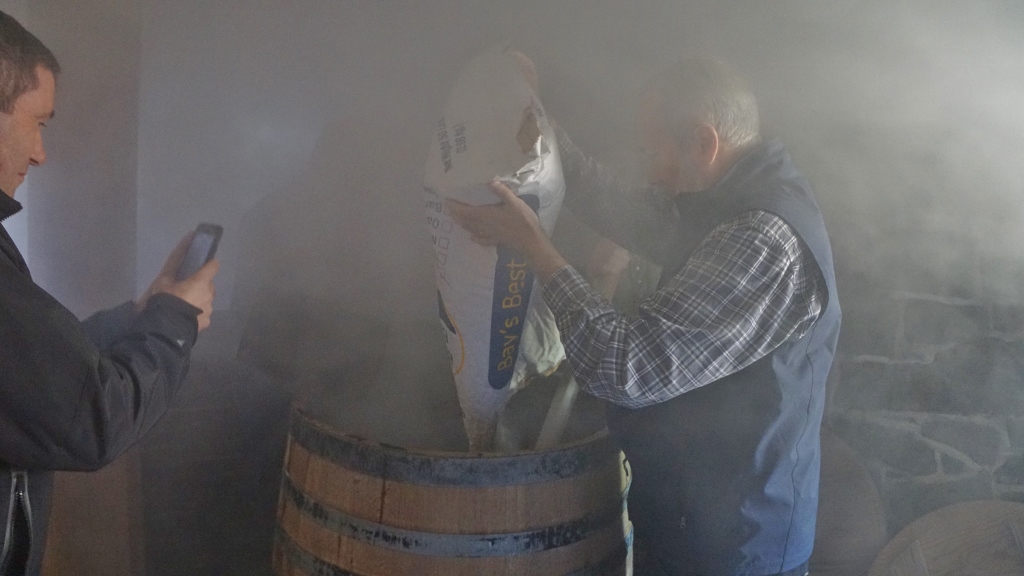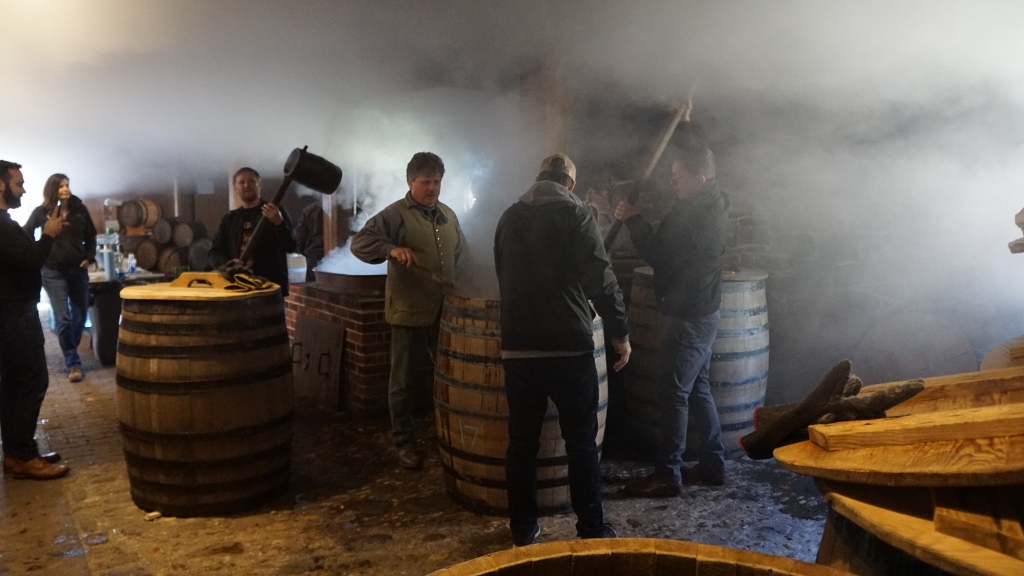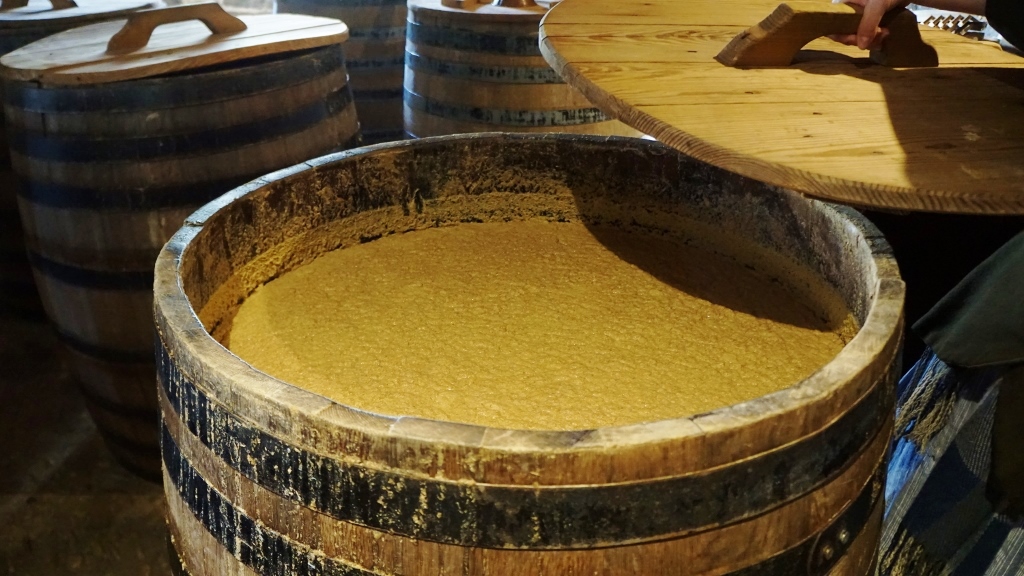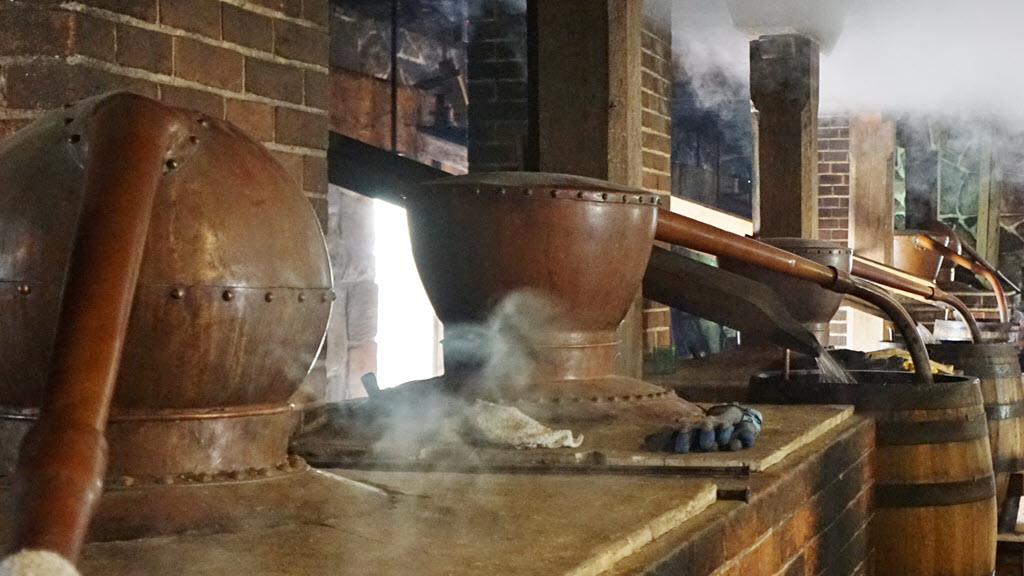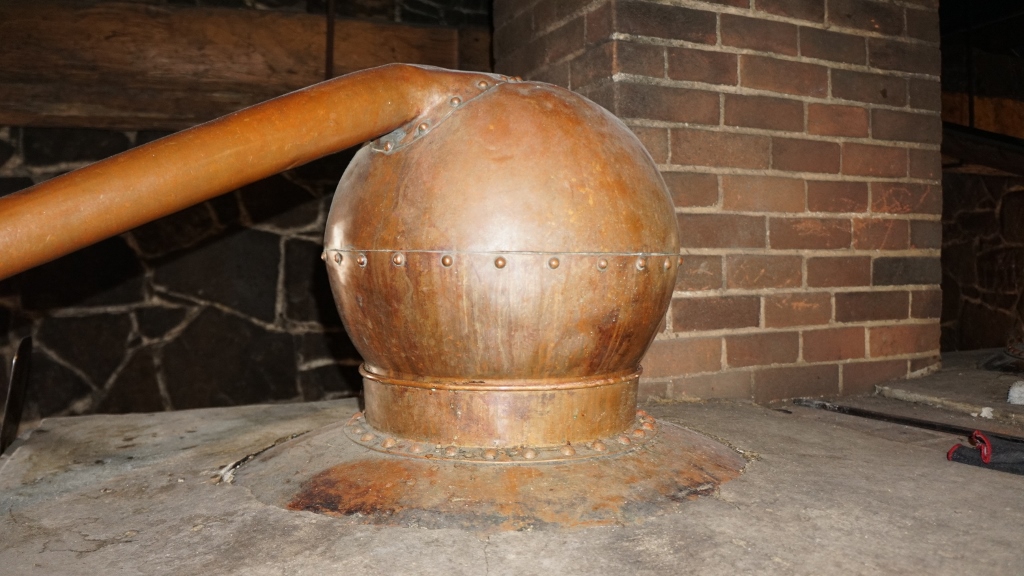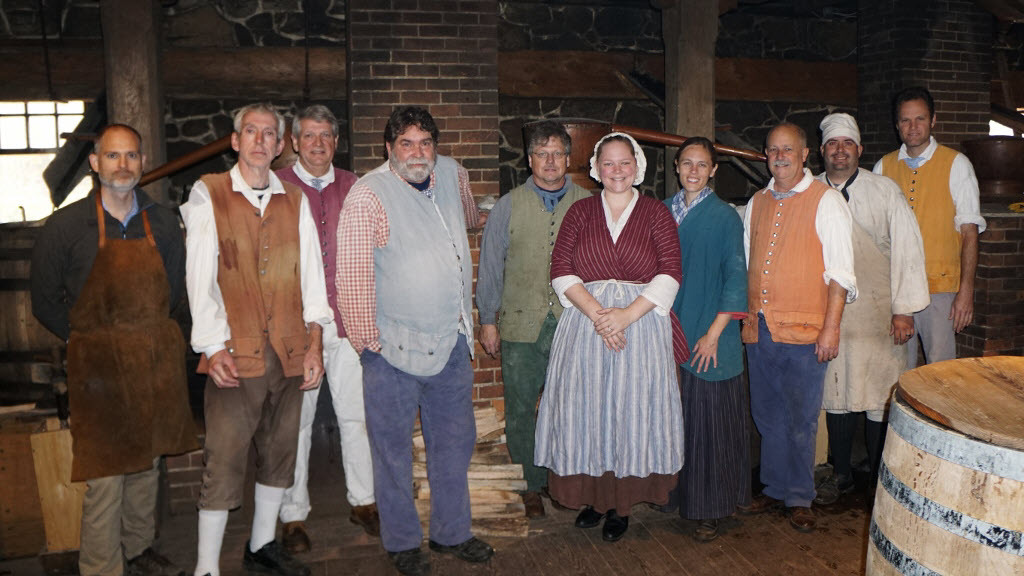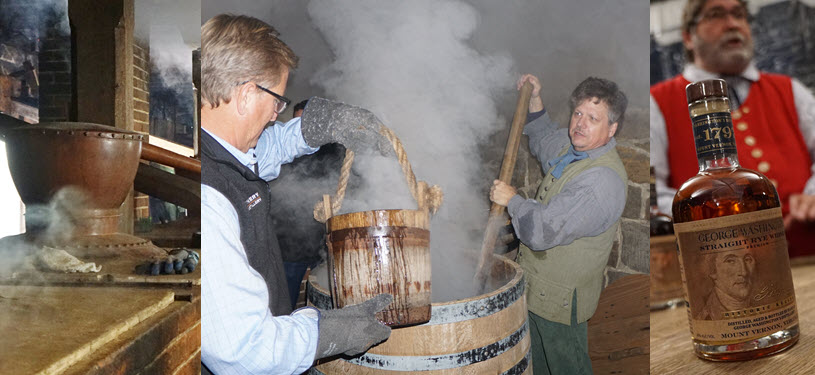
Everyone knows George Washington was a General in the Revolutionary War and served as the first President of the United States. What a lot of people don’t know is that he was also one of our nation’s earliest serial entrepreneurs. Washington was a farmer, soldier, statesman, husband and beginning in 1797 a distiller. Yes, the same year he retired as the nation’s first President he started a distillery.
In October 1796 Washington hired a Scotsman by the name of James Anderson to manage his farm. Anderson and his family had moved to the United States in the early 1790s after owning his own farm, mill and distillery near Inverkeithing, a village about 40 miles north of Edinburgh, Scotland. In the winter of 1797 Anderson made a proposal to Washington to start a distillery at Mount Vernon next to the gristmill. Not knowing anything about the business of making spirits Washington trusted the Scotsman who was an experienced distiller and agreed to let him build a distillery. A year later, a 75’x 30′ (2,250 square foot) stone walled distillery was operational with a boiler, mash tubs, five copper pot stills and the serial entrepreneur had started a new business.
By 1799 George Washington’s Distillery and Gristmill became the largest commercial distillery in the United States. Washington who was well known for keeping meticulous hand-written records show the distillery was making 11,000 gallons of whiskey a year with a value of more than $7,500 (about $120,000 today). The whiskey business turned out to be the most profitable of his many businesses.
Unfortunately, later that year on December 14th, 1799 Washington passed away and within a few years the distillery ceased operation. Historic records show the distillery burned down in 1814 and was not rebuilt.
What’s Does the George Washington Distillery & Gristmill Mean to You?
We had an opportunity to talk to many of the visiting distillers and crafts people at this years Fall distillation run at George Washington’s Distillery. Watch as they introduce themselves, talk about how they’re involved with the project and what this place means to them and the distilled spirits industry. We kick it off with an interview with Steve Bashore Director of Historic Trades at Mount Vernon, General George Washington himself in the flesh and many other distillers from around the country.
Podcast: Play in new window | Download
Subscribe: RSS
George Washington’s Gristmill and Distillery Archaeological Dig
In 1932 the state of Virginia purchased the property that was once home to the distillery and gristmill and in 1933 reconstructed the gristmill on its original foundation. The gristmill and miller’s house were operated as a state park until 1997. In 1995 the property and buildings were acquired by the Mount Vernon Ladies’ Association which oversees all of Mount Vernon.
The Association started archaeological research on the property and excavated the distillery building between 1999 and 2006. The digging and research uncovered the location of the original boiler and five stills.The distillery that was once lost to fire and neglect was ready to rise from the ashes. The reconstruction project started in 2005 and took two years to complete.
It’s hard to believe in today’s distilled spirits boom but if you look close at the rendering and photograph there was a utility line that was cut smack dab diagonally through the distillery foundation. On the bright side, the other thing you can see from the photograph are many of the original stones that were once walked on by George Washington and James Anderson. These same stones are once again exposed and regularly covered with the dust from freshly milled corn, wheat and barley as distillation has returned to Washington’s Distillery.
A Day on the Trail at George Washington’s Distillery & Gristmill
It’s really hard to express how magical this place is not only from a craft spirits distillery point of view but as a historically significant part of American history. When you visit just close your eyes and try to imagine yourself getting into a car with Marty McFly as you fiddle with the toggle switches and travel back 220 years to a time prior to; indoor plumbing, electric pumps, automatic valves and automatic gauges. Before you open your eyes take a moment to breath in the smell of steam billowing through the building, the sweet scent of mash fermenting in the oak hogshead barrels and take in the smell of the campfire-like smoke coming from below the wood fired stills. As you open your eyes you’ll find yourself standing on the same river stones where President George Washington once stood alongside his distiller James Anderson.
Reconstruction of the distillery building was completed in 2007 and a still was run enough to fill one small barrel. The first production run was done in 2009 when a dozen fermenters were set and the distillery produced about 100 proof gallons of spirits. These days the distillery is producing 1200 to 1500 proof gallons a year.
“This place (George Washington’s Distillery & Gristmill) has my heart and soul, it gets you back to the basics, the basic elements, everything I love about distilling.”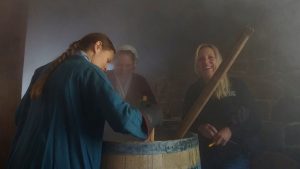
~ Lisa Wicker, Head Distiller and General Manager at at Widow Jane Distillery.
Distillation at the distillery happens two times a year in the spring and in the fall. Tours happen all summer long between the distillation seasons. The two operations don’t happen simultaneously because as an operating distillery using old-time production methods with open vats of boiling hot water, bucket brigades slinging hot water and hot mash alongside wood-fired stills and tourists don’t really go well together. It’s nothing like a modern craft spirits distillery that’s usually steam driven and valves and pipes are used to move hot liquids around the distillery and visitors are safe from harm. There is simply too much going on to provide a safe environment for workers and tourists.
Visiting Distillers at George Washington’s Fall 2019 Distillation Run
Here are many of the visiting distillers that had the pleasure of rolling up their sleeves to help with the Fall 2019 distillation run.
From left to right this years group included Laura Fields – Founder of the American Whiskey Convention and CEO & Founder of the Delaware Valley Fields Foundation; Bill Thomas – Owner Jack Rose Dining Saloon and The Imperial a new brandy bar and restaurant; Lisa Wicker – President and Head Distiller at Widow Jane Distillery and George Washington Distillery Consulting Distiller; Steve Bashore – Mount Vernon Director of Historic Trades and George Washington’s Distillery and Gristmill Head Distiller and Master Miller; Becky Harris – Founder and Chief Distiller at Catoctin Creek Distillery; Ted Huber – Owner & Master Distiller at Huber’s Starlight Distillery; Thomas Earl McKenzie – Master Distiller and Consultant; Mark Tennyson – Mount Vernon Tour Guide and Distiller; John Campbell – Master Distiller Laphroaig Distillery, Scotland; Dave Scheurich – Master Distiller Boondocks American Whiskeys; PJ Orlandi – Virginia Portfolio Manager, Beam Suntory; Ryan Lyles – Virginia Portfolio Manager, Beam Suntory; and Simon Brooking – Master Ambassador for Laphroaig Distillery.
George Washington Distillery Operations
For anyone that’s visited a craft spirits distillery many things will look familiar. The biggest difference isn’t so much what you’ll see, its more what you won’t see like modern electric pumps, impellers, pipes, valves, boilers or chillers.
The distillery was rebuilt as close to original as possible based on the archaeological findings. The boiler is a 210 gallon open top tank that is the starting point of all cooking. For safety reasons the boiler is heated with electric elements rather than open flame. From there a bucket brigade of Mt. Vernon trades people and volunteers fill buckets and deliver them one at a time to fill the 110 gallon hogshead barrels with boiling hot water. Depending on the mash bill corn, wheat and malted barley are added one at a time based on the temperature. As the grains are added the wooden rakes are dropped in the barrel and the hard work of rowing begins.
It was fascinating to listen to the rhythm of the wooden rake at different times. Watch the video and you’ll see Laphroiag Master Distiller John Campbell get his rhythm on as he mixes the mash. The beat slows as more water and grains are added. What starts out as easy to move water soon changes to a slurry as more and more grains enter the barrel. The mash bill will vary based on whether distillation is happening for a bourbon or rye whiskey or perhaps a fruit based peach or apple brandy. One of the few modern day tools used is an electronic thermometer. Distillation is all about heating and cooling at the right temperatures. As cooling occurs the yeast is eventually added and the mash is allowed to ferment for three to five days.
“Bringing the historic value back to the industry is a great thing. When people visit Mount Vernon they see what the agricultural side of George Washington was and also the distillation side. Touring the gristmill and touring the still house it’s amazing how it was redone and how it’s operated today making the rye whiskey. People can really get a sense of how things were made and the labor and everything it took to do a project like this.”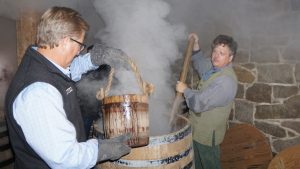
~ Ted Huber, Owner and Distiller at Huber’s Starlight Distillery
Once the fermentation cycle is complete the mash is moved by wooden bucket to one of the stills. The stills are not the original stills but they are designed based on some stills that were discovered in the area that would represent historic stills used in Virginia in the late 1700s. There are five all copper wood fired stills that were meticulously replicated by Vendome Copper & Brass Works. Each still is wrapped in brick and is heated from below with a wood fired box with a moveable steel door. The Mount Vernon distillers are constantly tending to the fires. Steve points out that back in 1700s these stills would have been tended to by slaves. The historical records have the names of six slaves including Hanson, Peter, Nat, Daniel, James, and Timothy.
We spoke with Mike Sherman of Vendome Copper & Brass Works to get some insights on the stills. He shared that the overall design was based on some historical stills that were found in Virginia and Kentucky that were believed to have been from that era. The American History Museum in Washington, D.C. had one still and the Oscar Goetz Museum in Bardstown, Kentucky had a similarly shaped still.
“When it came time for the still to be fabricated we came to Washington, D.C. to the American History Museum,” said Sherman. “They had a still in the back that had a stencil on it that read 1794 so we felt like this was a similar still that maybe Washington would have had. Rob Sherman and I came up (from Kentucky) and we took every possible measurement about every three inches up on it measuring the diameter, the circumference, took pictures of the exact way the rivets looked. Then we went back and said we could make this thing look exactly the way it was. Then we had the still made and then did the coil. It’s one of the greatest projects we’ve ever worked on.”
We asked Mike what difference the shape round onion vs. the crowned onion has on distillation. Mike said, “The idea of the “onion” is that the vapor velocity slows and the vapor that goes to the outside part of the onion will condense against the cooler surface and create some reflux that will drip back down in into the pot and be redistilled. It helps bring the proof up and it also gives the alcohol vapor more copper contact which creates a better product.”
George Washington’s Distillery Copper Pot Stills
Like most craft spirits distilleries each of the five stills has a name. The gallons vary and there are two onion designs. The two on the ends are mostly round while the three in the middle feature a crown shaped onion on the top. All five feature a goose neck that leads to a barrel with cold water running across copper cooling worms. Let’s introduce you to each of the stills from left to right.
- Helen is 90 Gallons with a Rounded Onion on Top – Helen is named after distiller James Anderson’s wife.
- Jane is 85 Gallons with a Crowned Top – She was originally named Pam but changed in 2018 as an omage to Lisa Wicker of Widow Jane Distillery.
- Maggie is 70 Gallons – Maggie revealed her name one late night in 2009 while Steve Bashore was distilling with Dave Pickerell as they were listening to Rod Stewart. “You stole my heart.”
- Anne is 75 Gallons – She was originally named Sondra for years but changed to Anne or Annie after Queen Anne.
- Elizabeth is 75 Gallons – And last but not least is Elizabeth. Steve said, “In the early runs we did not run her, as our runs were smaller, so she was known as the Virgin Queen, but since christening and fired, we liked Elizabeth, so it has stuck.”
Raise your hand if you love to hear how stills got their names!✋
Once the spirits start coming off the still you can hear the cheers in the room as folks run to taste the freshly made spirits. Then it’s time for the professionals to decide when it’s time to make the head, hearts and tales cuts.
Some product will be bottled immediately as unaged spirits and make its way to the Mount Vernon gift shop for sale. The rest will be barreled and aged until it hits the right flavor profile.
At the end of a long day as with any distillery it’s time for the cleaning of fermentation tanks, stills, rakes, buckets and more. Distilling starts bright and early again tomorrow.
In the case of George Washington’s Distillery and Gristmill it will soon be shut down for the winter months only to begin again in the spring. This cycle sounds a bit odd in today’s world of craft spirits but back in the day most farm based distilleries would only distill one to two months out of the entire year. Make sure you put George Washington’s Distillery & Gristmill on your bucket list.
“It’s important because the story of whiskey is intrinsically connected in the history of this country. You don’t have to go far back in Washington’s life to like 1794 with the Whiskey Insurrection. Some of you may think of it as the Whiskey Rebellion. Washington would refer to it as an Insurrection. It was the first challenge to the new Federal Government. This intrinsic connection is an important story and it needs to be told. And not just that rebellion but how whiskey was a critical commodity in commerce from the very beginning, from the founding.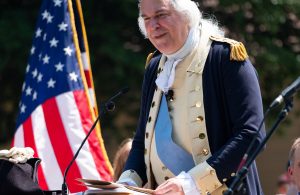
Q: What was George Washington’s favorite adult beverage?
A: His favorite probably would have been in the wine family but he certainly enjoyed a whiskey from time to time, for medicinal purposes.”
~ Dean Malissa – The Official Portrayer of George Washington at Mount Vernon
“This place is important to me because it’s shown me an art and a craft that’s probably been lost in Scotland. We have moved on so far away from this. This is our heritage, it’s your heritage, it’s everyone’s heritage, it’s how whiskey would have been made 200-300 years ago…To the industry this is legacy, it’s legacy to everyone. This is the industries heritage.”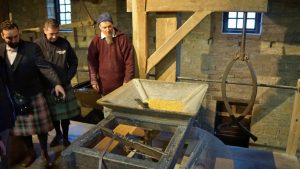
“As I come back more often the bond grows stronger and you want to be back more often. It’s just amazing. It’s starting to feel like family now.”
~ John Campbell Master Distiller Laphroaig Distillery
“We support this place…simply because Kentucky can’t be the only place that is known for whiskey (laughs). It’s my way to try to help out to make it aware that there was distilling in this region including Virginia, Maryland, Pennsylvania, the Northeast and Rye.”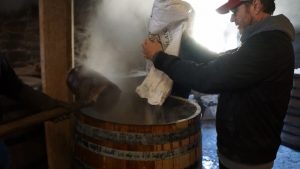
“The actual name of Jack Rose comes from this distillery. The reason that I named Jack Rose, Jack Rose, its named after the classic cocktail which is served with apple brandy or applejack and George Washington distilled it here. When I was looking for historical tie in for the bar it was all about George Washington, Mount Vernon and the fact that he did apple brandy. So the actual Jack Rose name is actually founded here from Mount Vernon.”
~ Bill Thomas Owner of Jack Rose Dining Saloon
“This is about connecting people back to the history of whiskey…When I found out that the distiller here for George Washington was a Scotsman there was an instant connection. There is nowhere else in American like this site for its history and giving people perspective on the historical aspect of whiskey making… It’s important to understand the traditions.”
~ Simon Brooking – Master Ambassador for Laphroaig Distillery
“Mount Vernon is in and of itself is an incredibly special place. We are celebrating George Washington as not only a founding father but an entrepreneur. What we do here at Mount Vernon is share with the over 1 million visitors per year, Washington’s approach to business, his diverse business models and especially our distillery. It’s an aspect of Washington’s life and business that most people don’t know anything about. We are doing what Washington’s distillers did back in the 18th century making Washington’s whiskey.”
~ Sam Murphy – Manager Historic Trades at Mt. Vernon
Mount Vernon Historic Trades Staff Working at the Distillery
These folks split their time between the distillery and Mount Vernon.
From left to right are Marshall Scheetz – Jamestown Cooperage Master Cooper; Eric Barton – Tour Guide, Distillery and Gristmill Production; John Kleiber – Tour Guide, Distillery and Gristmill Production; Sam Murphy – Mount Vernon Manager of Historic Trades, Tour Guide, Distillery and Gristmill Production; Steve Bashore – Mount Vernon Director of Historic Trades and George Washington’s Distillery and Gristmill Head Distiller and Master Miller; Katie Watkins – Tour Guide, Distillery Production; Megan Romney – Interpretive Operations Coordinator, Textile Demonstrator, Distillery Production; Mark Tennyson – Mount Vernon Tour Guide and George Washington’s Distillery Distiller; Justin Cherry – Owner Half Crown Bakehouse, Chef, Traditional Baker and Mount Vernon Food Consultant; Tyler Smith– Tour Guide, Distillery Production.
Stay Informed: Sign up here for the Distillery Trail free email newsletter and be the first to get all the latest news, trends, job listings and events in your inbox.
Learn more about George Washington’s Distillery and Gristmill.
Learn more about Virginia Distilleries.
Please help to support Distillery Trail. Sign up for our Newsletter, like us on Facebook and follow us on Twitter.




